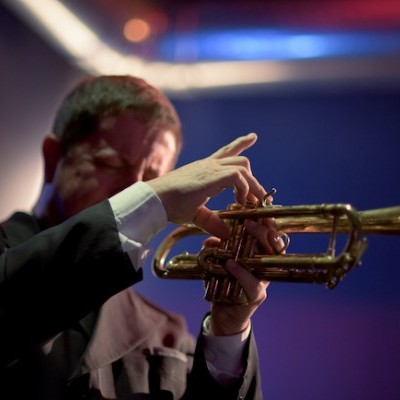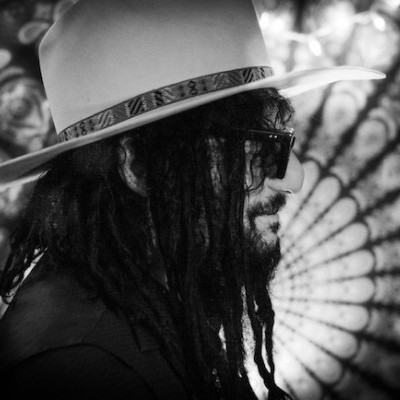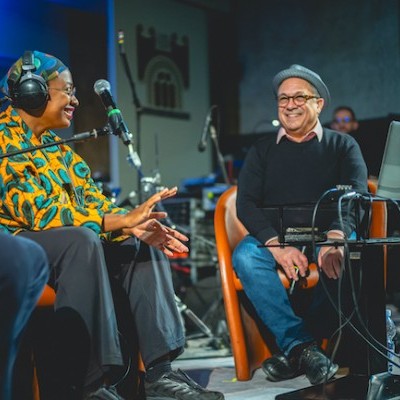Jul 9, 2024 11:35 AM
Trumpeter, Educator Jim Rotondi Dies at 61
Jim Rotondi, a renowned hard-bop trumpeter, composer and educator, died suddenly on July 7 at a hospital in France. He…

“For me, Roy Hargrove was one of the most dedicated stewards of this music, the Black American tradition,” said trumpeter Theo Croker, who considered Hargrove a mentor.
(Photo: Mark Sheldon)Three years after he passed away on Nov. 2, 2018, at age 49, trumpeter Roy Hargrove enters the DownBeat Hall of Fame. He was voted in by the readers of DownBeat in the 86th Annual Readers Poll.
A transitional figure who profoundly influenced a generation of musicians, Hargrove bridged the worlds of hard bop, hip-hop, funk and neo-soul throughout his prolific career, serving as a role model for young trumpeters to find their own voices in his wake. As close friend and mentee Maurice “Mobetta” Brown, a trumpeter from the south suburbs of Chicago put it, “The first time I heard him play, it made so much sense to me because it showed me other possibilities outside of what I was hearing at the time. He was the guy that let me know that, ‘Hey, it’s OK to push and express yourself.’”
Brown, who appeared on The RH Factor’s 2003 album Hard Groove, added, “I visited him two weeks before he passed away. He gave me one of his horns. I didn’t even know that he was sick like that. I just downplayed it. So I got the horn and said, ‘Thanks so much.’ But I didn’t realize that that would be the end.
“He was definitely a mentor of mine,” Brown continued. “He was not a guy who would sit down and show you stuff, but the fact that I would have access to him, to hang out with him and do stuff, meant a lot to me. I learned a lot just being around him and watching how he operates.”
Rising star trumpeter Giveton Gelin is another young player who was inspired by Hargrove’s example. “Roy was always the trumpet great that I found myself being drawn to again and again,” said the 22-year-old Bahaman musician, who performed at a star-studded, five-hour musical blowout at Rose Theater on Jan. 8, 2019, to celebrate Hargrove’s memory. “I listen to his music today, and it hits me like it’s the very first time. His sound pierced through the horn like a light beam. His sound transcends all things fixed. His sound will be with us forever.”
Neo-jazz star Theo Croker, whose critically-acclaimed 2019 album Star People Nation catapulted him into the limelight, saw Hargrove as one who embraced the tradition, as well as music in its wider context.
“For me, Roy Hargrove was one of the most dedicated stewards of this music, the Black American tradition, Croker said. “He could play everything on a high level without disregarding any other aspect of the music. He could come out on a rap song with Common and play bebop — the vocabulary of Charlie Parker and Dizzy Gillespie — with the swing of Louis Armstrong, the intensity of Freddie Hubbard, and the soul of Lee Morgan. Roy was one of the greatest that’s ever lived. Musically, he showed us that all of these different aspects of Black American music belong together and how important it is as young Black artists to understand our language and vocabulary. He showed us by incorporating it into his music and putting it all on the same level, not one above the other, as so many other people like to do.”
Croker explained how Hargrove’s respect and love for the younger musicians he inspired went above and beyond, often playing out in unexpected ways. “When my career was first starting, any time Roy heard me on the radio he would call and congratulate me. Roy invited me to his crib, introduced me to transcribing Fats Navarro, and gave me a Martin Committee trumpet that I still use to this day, simply because he believed in me. On my (2014) album AfroPhysicist, I had recorded his song ‘Roy Allan,’ and called him from the studio phone to tell him I was doing it. He came by and sang on it! By doing these things, I felt supported and loved by Roy. Over many conversations, he would always try to instill upon me understanding rhythmic and harmonic things out of the vocabulary of our Black masters like Dizzy Gillespie and Charlie Parker. I still have recordings of conversations we had.”
In a 1990 New York Times Magazine article, coinciding with the release of his debut on the RCA/Novus label, Diamond in the Rough, Hargrove told writer Tom Piazza: “To get a thorough knowledge of anything you have to go to its history. I’m just trying to study the history, learn it, understand it, so that maybe I’ll be able to develop something that hasn’t been done yet.”
Born in Waco, Texas on Oct. 16, 1969, Roy Anthony Hargrove was a preternaturally gifted trumpeter who began playing his father’s cornet at age nine. With a maturity beyond his years, Hargrove’s playing began turning heads when he attended Booker T. Washington High School for the Performing and Visual Arts in Dallas. Wynton Marsalis, who met Hargrove in 1987 during a performance/workshop at the school, was one of the first to spread the word about the budding trumpet star. Marsalis invited the 17-year-old Hargrove to perform with his quintet at the Caravan of Dreams Performing Arts Center in Fort Worth, Texas. At first, Hargrove did not take up Marsalis’ offer. But after three nights of the run, he built up the courage to sit in. That one event gave him the confidence to return to the club again and again while in high school to sit in with the likes of Dizzy Gillespie, Herbie Hancock, Freddie Hubbard and Bobby Hutcherson.
Hargrove’s reputation grew rapidly and reached the North Sea Jazz Festival’s Paul Ackett, who arranged for the young trumpeter to perform there in July of 1987, leading to a month-long European tour. Word quickly reached the heads of jazz record labels in New York. Around that time, Bruce Lundvall, the legendary president of Blue Note Records then, excitedly played this writer a tape of “this kid from Dallas who sounds like Clifford Brown.”
From Dallas, Hargrove enrolled at Berklee College of Music in 1988, but Boston was too far from where he wanted to be. A year later, he transferred to The New School in New York, and became a ubiquitous figure on the scene, hanging at The Jazz Gallery, sitting in at Small’s until the wee hours and frequently participating in the late-night jams at the Blue Note. The diminutive figure of Hargrove could be seen nervously pacing the floor of the subterranean Small’s until it was his time to sit in, and then unleashing his horn with an assertive, fireball intensity that rivaled his role model Freddie Hubbard in his prime. Indeed, Hargrove felt about Hubbard the way that Gelin, Brown and Croker would later come to feel about him — a towering figure with a magnetic, overpowering attraction.
Hargrove’s first sideman sessions in New York came in 1988–’89 with alto saxophonist Bobby Watson (No Question About It, Blue Note), tenor saxophonist Ricky Ford (Hard Groovin’, Muse), drummer Carl Allen (Piccadilly Square, Timeless) and Don Sickler (Superblue, Blue Note) before he recorded his debut as a leader, Diamond In The Rough, at age 20.
He followed with a string of superb offerings for the RCA/Novus label, including 1991’s Public Eye (with altoist Antonio Hart, pianist Stephen Scott, bassist Christian McBride and drummer Billy Higgins) and 1992’s The Vibe (with Hart, pianist Marc Cary, bassist Rodney Whitaker, drummer Gregory Hutchinson, guest tenorists Branford Marsalis and David “Fathead” Newman, plus trombonist Frank Lacy and organist Jack McDuff).
As a side project to his solo and quintet recordings, Hargrove was also the leader of The Jazz Networks, an ensemble which released five albums and featured other notable jazz artists, including Antonio Hart and Joshua Redman. Hargrove was commissioned by the Lincoln Center Jazz Orchestra and wrote “The Love Suite: In Mahogany,” which premiered in 1993. His 1994 outings, Blues ’N Ballads and Approaching Standards, highlighted the other side of his fiery trumpet style in the gorgeous tone he achieved on flugelhorn, especially on relaxed, lyrical ballads like “Easy to Remember,” “What’s New?” and “You Don’t Know What Love Is.” (Hargrove would pursue this mellower direction on his 1999 album, Hargrove With Strings, which featured his golden-toned flugelhorn work playing on moody standards like “You Go To My Head,” “A Time for Love,” “I’m a Fool to Want You” and “The Very Thought of You.”)
He experimented with a trio format on 1995’s Parker’s Mood, with bassist Christian McBride and pianist Stephen Scott, then won a Latin Grammy for his 1997 album Habana with his Afro-Cuban band Crisol. In 2001, he toured with tenor sax titan Michael Brecker and jazz piano legend Herbie Hancock, backed by the all-world rhythm tandem of bassist John Patitucci and drummer Brian Blade, resulting in the 2002 live Verve recording, Directions In Music: Live At Massey Hall, which won a Grammy for Best Jazz Instrumental Album.
The following year, Hargrove made a radical shift, incorporating funk and soul grooves into jazz with his hybrid band RH Factor while also performing and recording on the side with neo-soul singer D’Angelo during his Voodoo tour and appearing that same year on Common’s album Like Water For Chocolate and on Erykah Badu’s Worldwide Underground.
In that same incredibly productive year, he also appeared as a guest soloist on Shirley Horn’s last studio album, May The Music Never End (Verve), performing brilliantly on Duke Ellington’s breezy “Take Love Easy” and also on a chilling rendition of Harold Arlen’s “Ill Wind.”
Hargrove’s string of albums with RH Factor — 2003’s Hard Groove, 2004’s Strength, 2006’s Distractions — liberated a generation of aspiring trumpet players, allowing them to heed the call of bridging urban soul and jazz by incorporating hard grooves and the attitude of hip-hop along with potent improvisations. Those breakthrough albums featured the contributions of D’Angelo, Common, Erykah Badu, Karl Denson and Q-Tip.
He continued to embrace acoustic post-bop with his quintet on 2008’s Earfood, which included the ebullient and joyfully upbeat anthem “Strasbourg/St. Denis” (which had celebrants dancing in the aisles at Hargrove’s memorial) and also with his 19-piece big band on 2009’s Emergence.
Though Hargrove struggled with kidney failure and had been on dialysis for the last 14 years of his life (including while on the 2001 Directions In Music tour with Brecker and Hancock), he continued carrying the torch for jazz, gigging and sitting in until the end before passing away from cardiac arrest stemming from his long-time fight with kidney disease.
During the marathon Roy Hargrove memorial celebration at Rose Theater in Jazz at Lincoln Center, emcee Christian McBride, who knew the trumpeter since they were teenagers, described his late friend as “the kind of person you’re lucky to know once in a lifetime,” adding, “When you heard Roy play, you clearly understood where he was coming from. He was a man with a huge heart, lots of empathy and understanding. Roy understood that the key to unlocking the true wisdom in this music was to spend time around the elders. He couldn’t wait to spend time and talk with them. Roy decided to play the language of all his elders and gain their respect and, therefore, gain credibility, and then work on creating something fresh. What could be more fulfilling than that?”
This sentiment played out on Hargrove’s 1994 Verve album With The Tenors Of Our Time, which featured elders Johnny Griffin, Joe Henderson and Stanley Turrentine.
Always hip, later in the memorial proceedings, emcee McBride quipped that Hargrove was “the first brother I saw to wear Air Jordans with an Armani suit.”
In a cover story for the March 2006 issue of DownBeat, Hargrove talked to journalist Jennifer Odell about playing music that blended genres.
“It’s the same thing I used to see when I was going to Berklee. The jazz guys would be like, ‘The funk cats don’t know tradition, don’t know how to play, don’t know any harmony.’ And then the funk cats would be like, ‘You guys are too heady, never play the groove, play too many notes.’ But there’s a middle ground there, and it’s about understanding a style. If you’re gonna play some funk, you gotta know how to bring it in and not play too many notes.
“You gotta know how to give enough, to lend to the groove that makes people’s feet tap, makes them nod their heads or clap their hands. When you’re playing jazz, you have to have a knowledge of theory and dexterity. It’s a matter of being right in the middle.” DB

Jim Rotondi was acclaimed for his wide, round trumpet tone, remarkable virtuosity and assured swing.
Jul 9, 2024 11:35 AM
Jim Rotondi, a renowned hard-bop trumpeter, composer and educator, died suddenly on July 7 at a hospital in France. He…

Charles Lloyd, seen here at the 2024 New Orleans Jazz & Heritage Festival, makes DownBeat Poll history!
Jul 11, 2024 12:23 PM
The incomparable Charles Lloyd swept the 72nd Annual DownBeat Critics Poll, becoming the first artist ever to earn…

“Being president of Blue Note has been one of the coolest things that ever happened to me,” Was said. “It’s a gas to serve as one of the caretakers of that legacy.”
Jun 4, 2024 12:21 PM
Sitting with Don Was is a comfortable and unhurried exercise. He may seem slightly reserved at first, but ideas and…

“She reminds me of my childhood and makes we want to cry,” Cécile McLorin Salvant, pictured here with writer Ashley Kahn, said of Dianne Reeves.
Jun 11, 2024 12:31 PM
Italy’s Umbria Jazz Winter is one of those rare annual festivals that not only coincides with a major holiday —…

Maria Schneider said of Decades, her new compilation release: “I just wanted to create something, put it in a beautiful box and say, ‘Look at what we did.‘”
Jun 18, 2024 12:00 PM
Maria Schneider opened the sleek black box and placed it on a coffee table in her Manhattan apartment. Inside lay the…